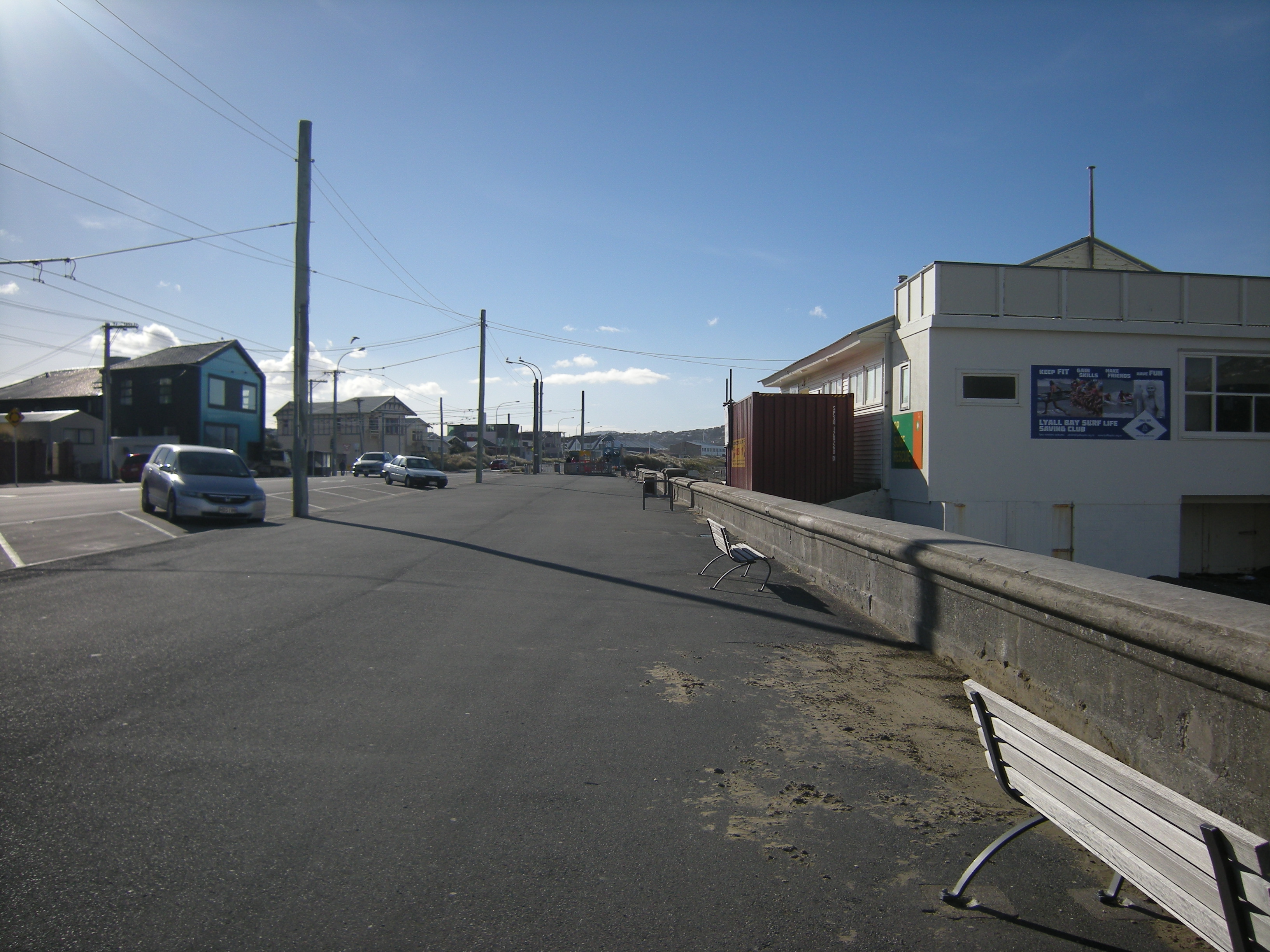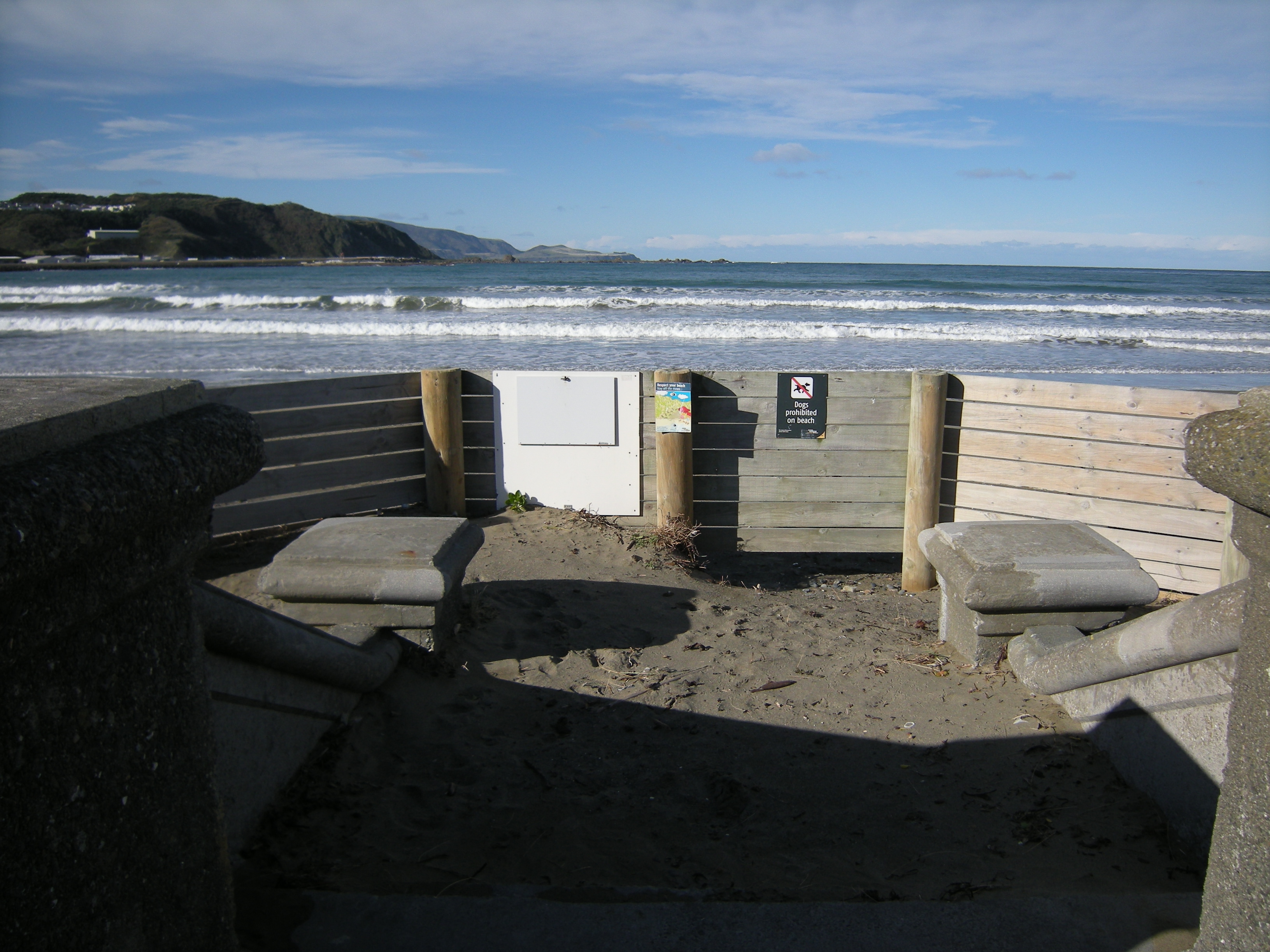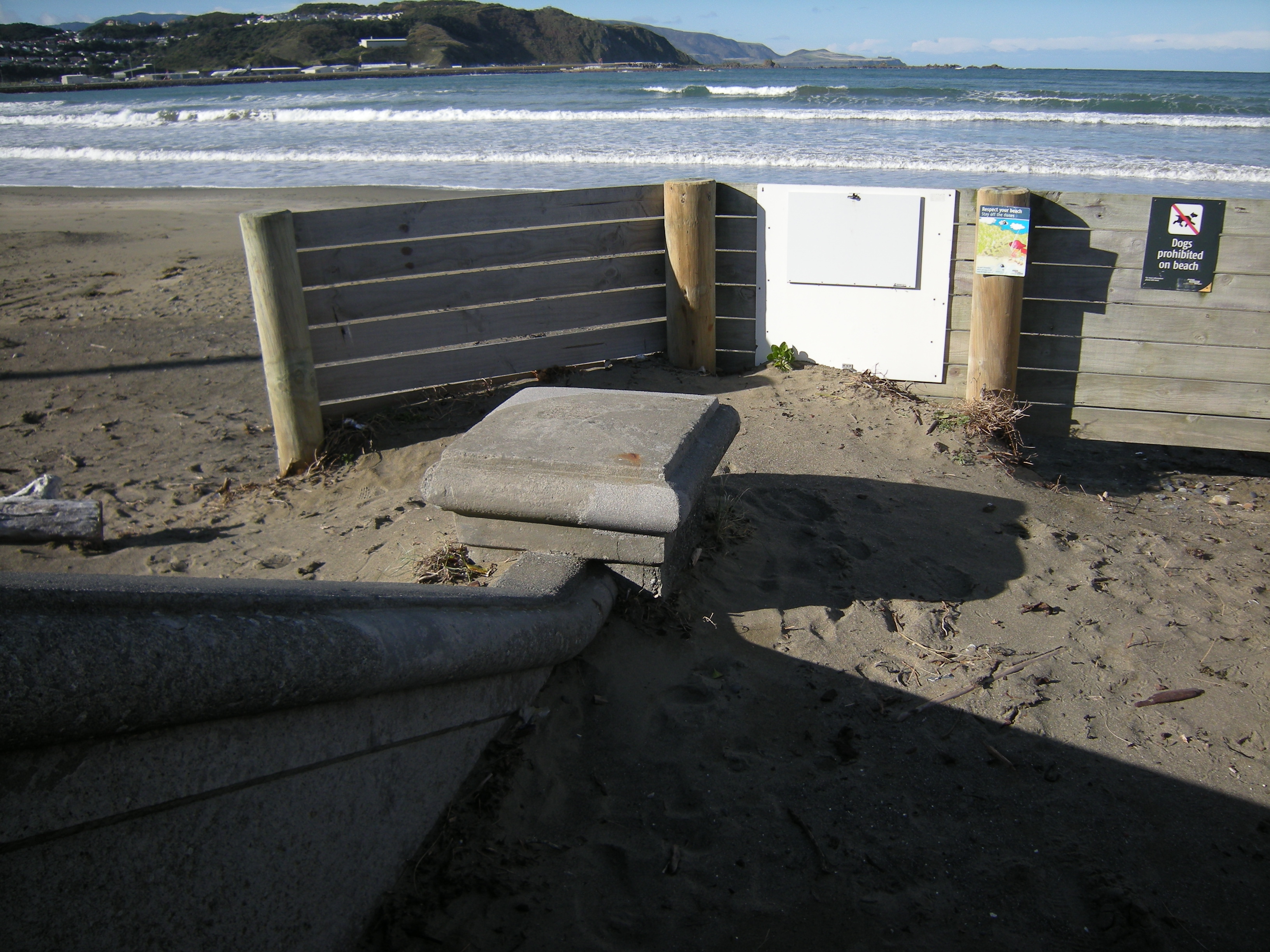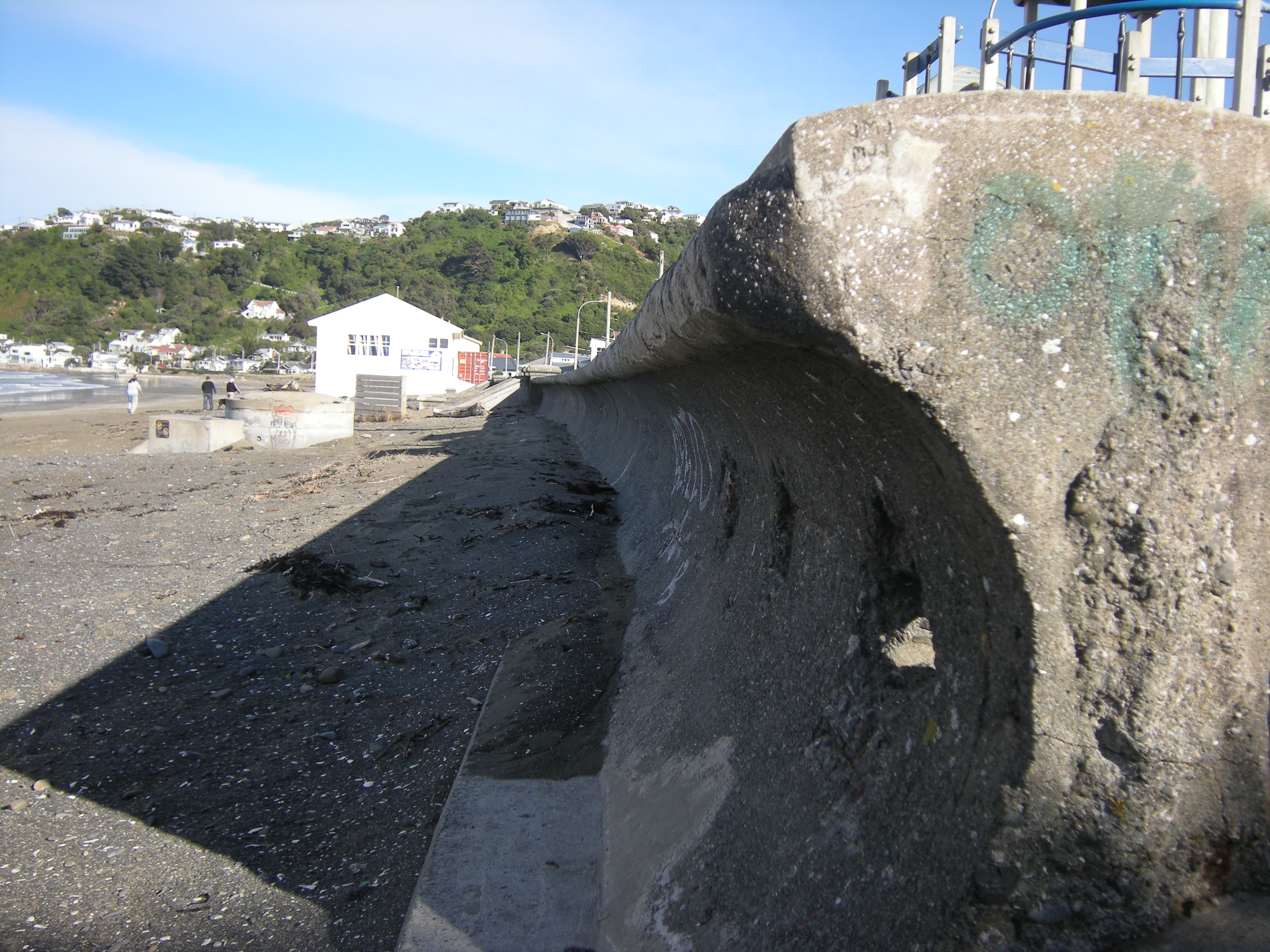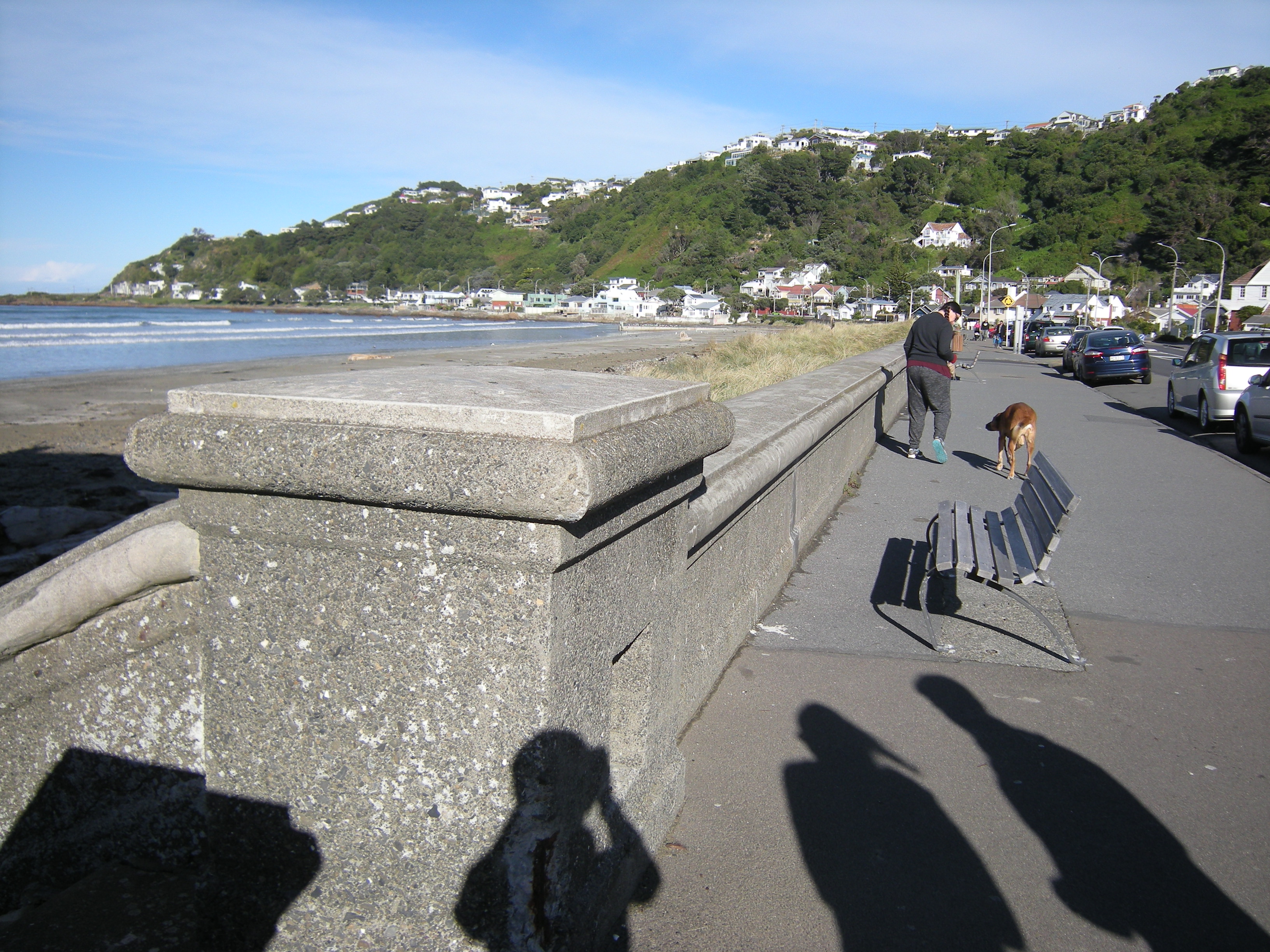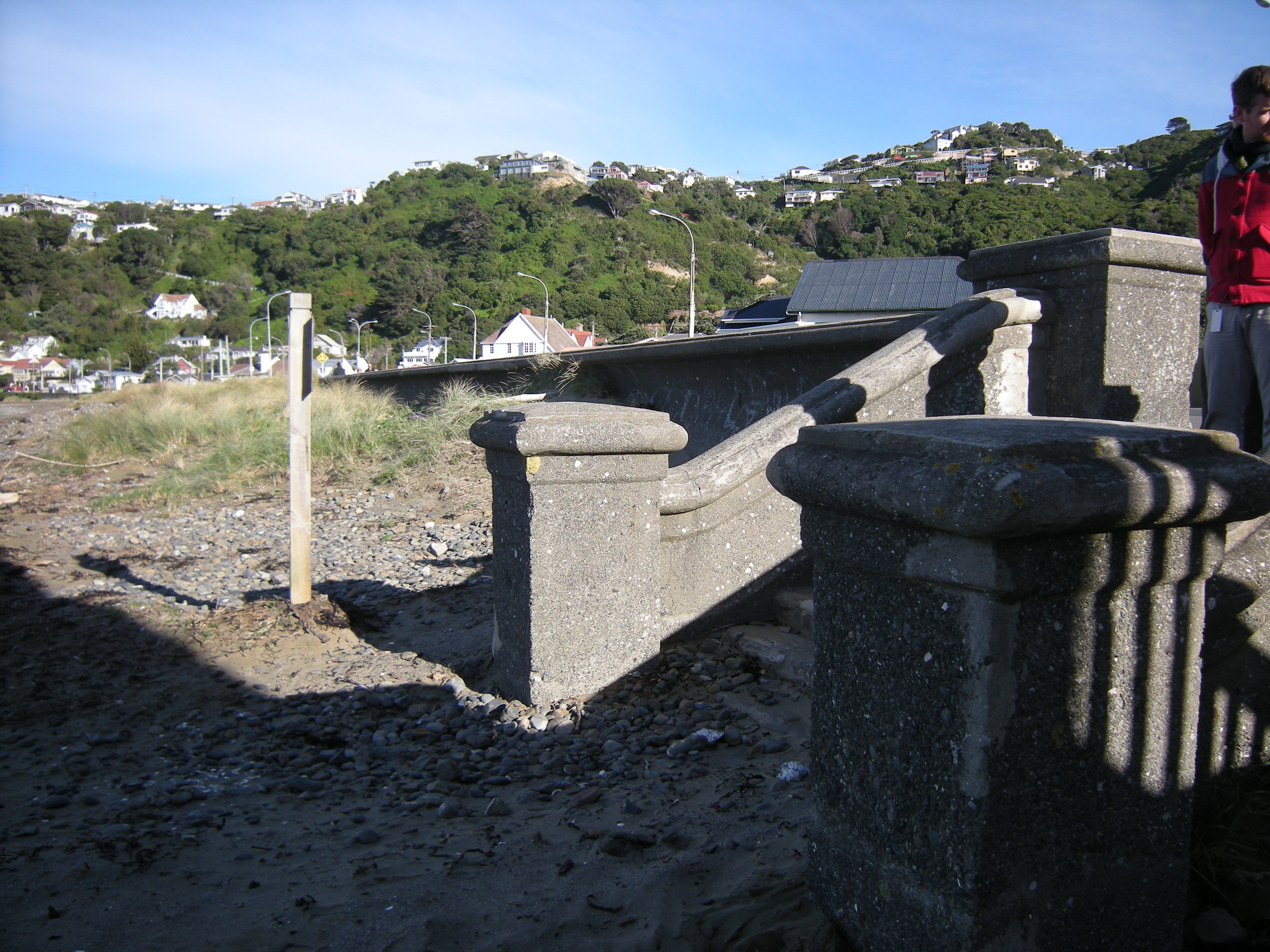Lyall Bay Sea Wall
Heritage object
-
Constructed
1932 - c.1970
-
-
Architect(s)
-
Builder(s)
Unknown
-
The Lyall Bay Sea Wall is a simple but elegant structure designed to cope with an extreme marine environment. For what could have been a prosaic structure, it has high aesthetic value.
The Lyall Bay Sea Wall is associated with suburban expansion in early twentieth century Wellington and the requirements in new amenities that movement brought. It has further significance as one of the public works ‘relief schemes’ of the Great Depression.
The Lyall Bay Sea Wall is an important structure in Lyall Bay’s streetscape and contributes to a sense of place and continuity in the suburb.
The Lyall Bay Sea Wall has tremendous amenity value, having served as a sandstop between the beach and the road and nearby properties for over eighty years.
-
Downloadable(s)
-
close
History
-
Lyall Bay has been a popular beach for Wellingtonians since around the turn of the twentieth century. An indication of the beach’s popularity was the establishment of two surf life saving clubs in 1911– Lyall Bay and Maranui – both of which still exist today. A sea wall had been mooted as early as 1914, to stop ‘the trouble caused by drifting sand’ , but it took almost twenty years for it to be built.
The sea wall was designed by the Wellington City Council Engineer in 1931 and built with labour from those registered on the Government’s unemployment scheme in 1932. The original plan provided for a wall to extend along Lyall Bay Parade from Queen’s Drives to Onepu Road. It had 7 formal openings that were framed by a pair of capped pillars, and which gave access to steps down to the beach. Minor openings (i.e. without pillars) provided access to the existing restrooms and clubrooms. The sea wall was designed as a battered concrete wall with a curved balustrade. It was constructed to prevent sand drift and to encourage the sale of land on the opposite side of the road.
The Director of Parks and Reserves reviewed the wall’s performance the year after its construction. He noted that a City Engineer had reported a saving of £600 due to the decreased level of sand blowing across the road, while the Tramways Manager had reported that less maintenance was required on the trams because of the wall. He also said that the residents seemed happy with it, though the sand still flew in a dry southerly ‘but no power on earth, or wall 50 ft high would stop that.’
The wall became known locally as the ‘whirler’ wall due to the effect of the wind funnelling along the curved beach face. During strong winds the sand whirled along the face of the wall and was then funnelled out the openings.
In the 1970s the wall was extended further east along Lyall Bay. A three metre length of the wall was removed in c.2003 to give access to the newly built unisex and accessible toilets, and to a cleaner’s room.
The heritage value of the Lyall Bay Sea Wall lies mainly in its amenity value. It was constructed in the 1930s to keep the sand from blowing across the parade and to a large degree it has done that ever since. Its age also gives historical value. It has aesthetic value: the wall’s strong continuity of line, formal stair openings, patina of age, and distinctive form and profile combine to make it an important and attractive landscape feature of Lyall Bay. The sea wall enhances its setting in the local streetscape and landscape. It is a strong object that makes a clear demarcation between beach and road and its style and evident age contributes to the sense of establishment of the area. These qualities are evident both from the landward and seaward sides of the wall, although the landward side offers a greater sense of the extent and continuity of the wall.
-
Modifications
close
-
1932
-
Construction
-
c.1970
-
Extension of sea wall to the east
-
-
Occupation History
close
Not assessed
-
Lyall Bay has been a popular beach for Wellingtonians since around the turn of the twentieth century. An indication of the beach’s popularity was the establishment of two surf life saving clubs in 1911– Lyall Bay and Maranui – both of which still exist today. A sea wall had been mooted as early as 1914, to stop ‘the trouble caused by drifting sand’ , but it took almost twenty years for it to be built.
-
close
Architectural Information
-
Building Classification(s)
close
Not assessed
-
Architecture
close
The sea wall is a simple but elegant engineering structure designed to cope with the rigours of its extremely exposed location within a severe marine environment. Similar to a small-scale military defence, it presents an upswept glacis to the beach side, overtopped with a heavy moulded coping that serves to turn much of the sand and spray back to the beach; its height varies from less than a metre where the dunes have accumulated in front of it, to between two and three metres where there is little sand. The coping profile is mirrored on the pavement side, where the wall is generally less than a metre high. At the ends of the wall, the coping returns on itself to provide a simple and neat visual finish to the structure.
The old wall runs between its end points in two major straight-line segments set tangentially to the arc of the bay. The wall is interrupted by evenly-spaced openings for the stairs to the beach, the entry points to which are delineated with pairs of squat pilasters, and by the series of cuts in the wall made for the four existing buildings on the beach – from east to west, the two Lyall Bay Surf Club buildings, the small “affordable arts” building, and the Maranui building. These cuts include:
- No. 1 building – one cut, roughly 1 m wide
- No. 2 building – two cuts, one roughly 1 m wide, the other roughly 3 m wide
- Affordable Arts building – two cuts, roughly 1.2 m wide each
- Maranui – one cut, roughly 6 m wide
-
Materials
close
The original construction is in cast in-situ concrete with some steel reinforcing and an off-form concrete finish generally. This surface has weathered over time to produce a slightly exposed aggregate type of finish. The street face, coping and the stairs are in finished in plaster to give a better quality of finish – the plaster for these surfaces is made using a beach sand aggregate with a high proportion of crushed shell that provides an interesting visual texture.
A cross section of the top part of the structure can be seen at one of the cuts for the No. 2 building that has been left more or less unfinished. The concrete is made with heavy aggregate with infrequent longitudinal reinforcement. The coping is formed up off the underlying concrete in plaster (modern cement plaster in this area).
-
Setting
close
The old sea wall runs from the Onepu Road intersection at the east to just past the roundabout at Queen’s Drive, stopping at the vehicle access point by the public toilets at the far western end of the beach, with 8 flights of steps to
the beach interspersed along its length. The wall is flanked by newer structures at either end – to the east, a concrete and concrete block wall that runs out into rock groins and barriers and a similar wall to the west that runs into the rocky foreshore at the other end of the beach.
The first two buildings stand off the wall by a short distance while the Affordable Arts building is built directly on the line of the wall with distinctive tapered pilasters supporting verandah posts and the wall of the building above. The Maranui building is constructed hard to the line of the beach face of the wall.
-
Building Classification(s)
close
-
close
Cultural Value
- The Lyall Bay Sea Wall is a simple but elegant structure designed to cope with an extreme marine environment. For what could have been a prosaic structure, it has high aesthetic value.
- The Lyall Bay Sea Wall is associated with suburban expansion in early twentieth century Wellington and the requirements in new amenities that movement brought. It has further significance as one of the public works ‘relief schemes’ of the Great Depression.
- The Lyall Bay Sea Wall is an important structure in Lyall Bay’s streetscape and contributes to a sense of place and continuity in the suburb.
- The Lyall Bay Sea Wall has tremendous amenity value, having served as a sandstop between the beach and the road and nearby properties for over eighty years.
-
Aesthetic Value
close
-
Architectural
Does the item have architectural or artistic value for characteristics that may include its design, style, era, form, scale, materials, colour, texture, patina of age, quality of space, craftsmanship, smells, and sounds?
The Lyall Bay Sea Wall has aesthetic value for its strong continuity of line, the formal stair openings, its distinctive form and profile, and the patina of age of the structure.
-
Townscape
Does the item have townscape value for the part it plays in defining a space or street; providing visual interest; its role as a landmark; or the contribution it makes to the character and sense of place of Wellington?
The Lyall Bay Sea Wall is one of the few key landmarks in an otherwise relatively featureless suburb. It is one of the beach’s defining features, and it makes a significant contribution to the character and sense of the place in Lyall Bay.
-
Group
Is the item part of a group of buildings, structures, or sites that taken together have coherence because of their age, history, style, scale, materials, or use?
Together with the Island Bay Sea Wall and the Oriental Parade Sea Wall, the Lyall Bay Sea Wall is one of a number of sea walls in Wellington that were constructed to deal with the issue of sand drift and create an interesting group of early protection works in Wellington.
-
-
Historic Value
close
-
Association
Is the item associated with an important person, group, or organisation?
The wall was built by the registered unemployed as part of a public works ‘relief scheme’ during the Great Depression.
-
Association
Is the item associated with an important historic event, theme, pattern, phase, or activity?
The Lyall Bay Sea Wall is associated with suburban expansion, and with the subsequent requirement for new amenities that suburban expansion brought. As people moved to or visited Lyall Bay in increasing numbers, and tram routes were adapted to take them there, a wall was required to stop beach-sand from piling on the roads, gathering in people’s properties, and damaging tram machinery. The Sea Wall contributes significantly to the historic character of Lyall Bay and is associated with the growing popularity of the beach for recreation and with the development of the suburbs in Wellington.
-
-
Scientific Value
close
-
Archaeological
Does the item have archaeological value for its ability to provide scientific information about past human activity?
The Maori site of significance Hue-te-para Beach (reference M78) is located further east along the beach from the historic sea wall.
-
Technological
Does the item have technological value for its innovative or important construction methods or use of materials?
There is technological interest in the wall’s curved face that is designed to deflect the eddies of wind- blown sand and return it to the beach and sand-dunes.
-
-
Social Value
close
-
Identity - Sense of Place - Continuity
Is the item a focus of community, regional, or national identity? Does the item contribute to sense of place or continuity?
Having being constructed over eighty years ago, the Lyall Bay Sea Wall contributes to a sense of place and continuity for the Lyall Bay community.
-
Sentiment - Connection
Is the item a focus of community sentiment and connection?
The Lyall Bay Seawall is a popular feature of the beachfront and has become part of the beach playground. People use the Seawall as a piece of street furniture, sitting on it, and sheltering behind it.
-
-
Level of Cultural Heritage Significance
close
-
Representative
Is the item a good example of the class it represents?
The Lyall Bay Sea Wall is a good example of the type of sea wall built in Wellington during the 1920s and 1930s.
-
Authentic
Does the item have authenticity or integrity because it retains significant fabric from the time of its construction or from later periods when important additions or modifications were carried out?
Though it has been modified several times over the decades, the Lyall Bay Sea Wall has a high level of authenticity and integrity as it has mostly retained its original materials.
-
Importance
Is the item important at a local, regional, national, or international level?
The Lyall Bay Sea Wall is important at a local level.
-
-
Local / Regional / National / International Importance
close
Not assessed
-
close
Site Detail
-
District Plan Number
4/33
-
Legal Description
None
-
Heritage New Zealand Listed
Not listed
-
Archaeological Site
The Maori site of significance Hue-te-para Beach (reference M78) is located further east along the beach
-
Current Uses
unknown
-
Former Uses
unknown
-
Has building been funded
No
-
Funding Amount
Not applicable
-
Earthquake Prone Status
Outside Earthquake Prone Policy
-
-
close
Additional Information
-
Sources
close
- Director of Parks and Reserves to the Town Clerk, ‘Re: Lyall Bay Sea Wall’, April 1st, 1933, in Wellington City Council file 00001:43:4;34.
- Fill, Barbara. ‘Draft Heritage Assessment For Resource Consent For Partial Demolition Of Seawall, SR 102480, Lyall Bay Parade, Lyall Bay.’ Draft Report. 11 June 2003
- Murray, Russell. ‘Lyall Bay Sea Wall: Heritage Report For Wellington City Council’. Unpublished. 30 April 2010.
- ‘Sand Drifts – Lyall Bay and Maranui – Improvements Wanted’. Evening Post. Volume LXXXVII, Issue 114, 15 May 1914, Page 10. Accessed June 2013 at Papers Past
- Wellington City Archives, Engineers Plan 7777 21:14:5, October 1931
- Wellington City Archives, Engineers Plan 4912, 21:14:2, June 1931
- Wellington City Archives, File Ref. 00001:48:4/48 (Lyall Bay Sea Wall)
- Technical Documentation close
-
Footnotes
close
Not available
-
Sources
close
Last updated: 9/25/2017 8:32:56 PM






